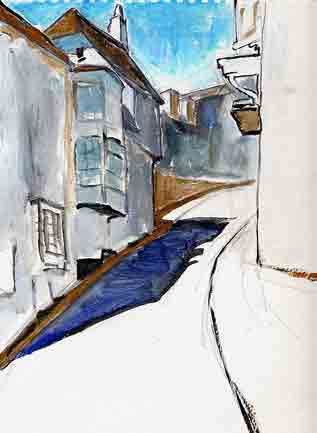|
This is now the town's main street, though it wasn't always. Nor is it called Main Street (as it would be in America) or High Street (as in the typical English town) but Broad Street. Is this a joke?

It got the name by contrast with even older and narrower Bridge Street (which you just came along) and Coombe Street (which you just passed and perhaps didn't even notice). The initial constriction is caused by the building-cluster on the left, which stands like a plug in Broad Street's lower end and contains shops in its lower floor, the Bell Cliff restaurant in the upper.
A D-shape is painted on the street surface below the projecting bay window of the Bell Cliff restaurant. This is to warn tall vehicles to keep out a bit; they have been known to hit that window.
After that, the scaffolding of the repairers makes this neck of the street even narrower. Scaffolding is difficult to stand on the steep slope: the legs have to be of different heights to keep the boards level.
After getting past this obstruction, Broad Street does suddenly open out. Indeed you find yourself ascending into the lower end of the main shopping street, a scene full of warmth and noise, coming from strolling shoppers and, quite possibly, from absurdly jammed traffic; and sometimes the welter of sound is delightfully threaded by the strains of a fiddle or accordion played by a busker.
The traffic is jammed because the street surface itself is hardly wider: the widening consists of a triangular space on the left, overlooked by an elevated sidewalk. This space is still called the Shambles. It was once a meat market, but is now just a cobbled slope where a few vehicles can park. Toward Christmas, it becomes a sort of theatre, where a choir of carolers performs from the balcony-like sidewalk to the crowd filling the street below.
(Or, in summer, notice the stone planter against the Shambles rear wall, full of tulips and pansies.)
x To enter Broad Street, whether climbing from the Cobb Gate or rounding the corner from the Marine Parade, is often to pass from blustery sea weather to relative calm and warmth. Perhaps the street originated not only as a route to Devon but as the exploitation of a sheltered fold behind the slight sea-front ridge.
The street rises until it rejoins its elevated sidewalk, and both continue uphill.
|
